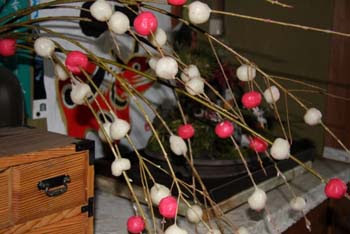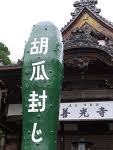. Legends about Silk and Silkworms .
::::::::::::::::::::::::::::::::::::::::::::::::::::::::::::::::::::::::::::::::::::::::::::::::::::
Silk (kinu) and related kigo
***** Location: Japan
***** Season: Various, see below
***** Category: Humanity / Animal
*****************************
Explanation

silkworm, kaiko 蚕
Tending to the silkworms was a local activity in many rural areas of the Edo period and many kigo related to these activities exist.
Japan was the most Eastern country of the old silkroad, reaching up to Rome in Italy.
According to legend, Otehime 小手姫, the empress-consort of Emperor Sushun 崇峻天皇の時代 (r. 587–92), fled to Kawamata after the emperor was assassinated in 592.
There she propagated the arts of sericulture, or silkworm cultivation, and weaving.
. Kawamata Silk 川俣シルク ー Fukushima .
- Reference - The History of SILK -
:::::::::::::::::::::::::::::::::::::::::::::::::::::::::::::::::::::::::::::::::::::::::::::::::::::
Silk is a natural protein fiber, some forms of which can be woven into textiles. The best-known type of silk is obtained from cocoons made by the larvae of the silkworm Bombyx mori reared in captivity (sericulture). The shimmering appearance for which silk is prized comes from the fibers' triangular prism-like structure which allows silk cloth to refract incoming light at different angles.
"Wild silks" or tussah silks (also spelled "tasar") are produced by caterpillars other than the mulberry silkworm (Bombyx mori). They are called "wild" as the silkworms cannot be artificially cultivated like Bombyx mori. A variety of wild silks have been known and used in China, India, and Europe from early times, although the scale of production has always been far smaller than that of cultivated silks. Aside from differences in colors and textures, they all differ in one major aspect from the domesticated varieties: the cocoons that are gathered in the wild have usually already been damaged by the emerging moth before the cocoons are gathered, and thus the single thread that makes up the cocoon has been torn into shorter lengths. Commercially reared silkworm pupae are killed before the adult moths emerge by dipping them in boiling water or piercing them with a needle, thus allowing the whole cocoon to be unraveled as one continuous thread. This allows a much stronger cloth to be woven from the silk. Wild silks also tend to be more difficult to dye than silk from the cultivated silkworm.
There is some evidence that small quantities of wild silk were already being produced in the Mediterranean area and the Middle East by the time the superior, and stronger, cultivated silk from China began to be imported.
China
Landscape of quick water from high mountain by Zhao Zuo, Ming Dynasty. Hand scroll, ink and colour on silk.Silk fabric was first developed in ancient China, possibly as early as 6000 BC and definitely by 3000 BC. Legend gives credit to a Chinese empress, Xi Ling-Shi (Hsi-Ling-Shih, Lei-Tus). Silks were originally reserved for the kings of China for their own use and gifts to others, but spread gradually through Chinese culture both geographically and socially, and then to many regions of Asia. Silk rapidly became a popular luxury fabric in the many areas accessible to Chinese merchants because of its texture and luster. Silk was in great demand, and became a staple of pre-industrial international trade.
The first evidence of the silk trade is the finding of silk in the hair of an Egyptian mummy of the 21st dynasty, c.1070 BC. Ultimately the silk trade reached as far as the Indian subcontinent, the Middle East, Europe, and North Africa. This trade was so extensive that the major set of trade routes between Europe and Asia has become known as the Silk Road.
The Emperors of China strove to keep knowledge of sericulture secret to maintain the Chinese monopoly. Nonetheless sericulture reached Korea around 200 BC, about the first half of the 1st century AD in ancient Khotan (Hill 2003, Appendix A), and by AD 300 the practice had been established in India.
© WIKIPEDIA has more !

Silk Brocade
shimin shioki 四眠四起 moulting four times

shimin 四眠蚕 four-molt silkworm, four-moulter, tetramoulter
蝶々や猫と四眠の寺座敷
choochoo ya neko to shimin no tera zashiki
a butterfly
a cat, four-moulters
in the temple guest room
Issa
:::::::::::::::::::::::::::::::::::::::::::::::::::::::::::::::::::::::::::::::::::::::::::::::::::
Let us look at some kigo.
kigo for late spring
silkworm, kaiko 蚕 (かいこ)
"mulberry child", kuwago 桑子(くわご)

"ant worm", baby silkworm, gisan 蟻蚕(ぎさん)

"hairy worm, hatchling, kego 毛蚕(けご)

"silkworms are sleeping" kaiko no nemuri
蚕の眠り(かいこのねむり), iko 眠蚕(いこ)
ioki いおき、iburi いぶり
kaiko sagari 蚕ざかり(かいこざかり)
"time of the silk worm" kaikodoki 蚕時(かいこどき)
thrown away silkworm, discarded siklworm, sutego 捨蚕(すてご)
kobushi こぶし
silkworm in spring, spring silkworm,
harugo 春蚕(はるご)
............................................
rearing silkworms, sericulture, raising silkworms,
kogai 蚕飼 (こがい)

© PHOTO : hikifuda collection, su-san
yoosan 養蚕(ようさん), saisei 催青(さいせい)
place for the silkworms, goza 蚕座(こざ)
hut, shed for rearing silkworms, kaiya 飼屋(かいや),
koya 蚕屋(こや), room for the silkworms, sanshitsu 蚕室 (さんしつ)
shelf, rack for keeping silkworms, kaikodana 蚕棚(かいこだな),
kodana 蚕棚(こだな)

- - - kaikozaru 蚕ざる
basket for keeping silkworms, silkworm cage, kokago 蚕籠(こかご)

loft, second floor for raising silkworms, kaikobeya 蚕部屋
Many old farmhouses were especially constructed for raising the silkworms in the second and third floor.
Shirakawa Farmhouses and Daruma Dolls
time for rearing silkworms, silkworm-raising time,
kogai doki 蚕飼時(こがいどき)
harubiki ito 春挽糸 (はるびきいと) "thread from spring"
.....

silkworm-egg card, silkworm egg paper , tanegami 蚕卵紙 (たねがみ)
tanegami 種紙(たねがみ), sanranshi 蚕卵紙(さんらんし)
sanranshi 蚕紙(さんし)
brushing silkworms from the egg paper, hakitate 掃立 (はきたて)
:::::::::::::::::::::::::::::::::::::::::::::::::::::::::::::::::::::::::::::::::::::::::::::::::::
humanity kigo for early summer
joozoku 上蔟 (じょうぞく)
putting silkworms on shelves to produce cocoons
for the first time
ko no agari 蚕の上蔟(このあがり)
agari iwai 上蔟祝(あがりいわい)celebrating the first silkworms producing cocoons
agari dango 上蔟団子(あがりだんご)
dango rice dumplings to celebrate the finished silk cocoons
mabushi 蚕簿(まぶし)shelves for the silkworms to retire producing cocoons
These harugo, haruko 春蚕 "silkworms of spring" are said to produce the best silk of the year.
.................................................................................
mayu 繭 まゆ cocoon
mayu kaki 繭掻(まゆかき)
mayu kai 繭買(まゆかい)
nama mayu 生繭(なままゆ)
mayu hosu 繭干す(まゆほす)drying cocoons
shirumayu 白繭(しろまゆ)white cocoons
kimayu 黄繭(きまゆ)yellow cocoons
They yield a natural yellow silk and are very percious.
. . . CLICK here for Photos !
tamamayu 玉繭(たままゆ)"round cocoons"
shinmayu 新繭(しんまゆ)new cocoons
kuzumayu 屑繭(くずまゆ)waste cocoons
the ones that do not yeald a thread

mayukago 繭籠(まゆかご)cocoon basket
To let the cocoons dry naturally.
mayudonya 繭問屋(まゆどんや)wholesale store for cocoons
mayuichi, mayu ichi 繭市(まゆいち)cocoon market
mayu sooba 繭相場(まゆそうば) retail market for cocoons
.................................................................................
animal kigo for mid-summer
natsugo 夏蚕 (なつご) silkworm in summer
lit. "summer child"
nibango 二番蚕(にばんご)"second child"
kaiko no ga 蚕の蛾(かいこのが)silkworm becoming a moth
sanga 蚕蛾 (さんが)
kaiko no choo 、蚕の蝶(かいこのちょう)butterfly from a silkworm
mayu no choo 繭の蝶(まゆのちょう)
mayu no ga 繭の蛾(まゆのが)
. . . CLICK here for Photos !
yamamayu 天蚕 (やままゆ) mountain silkworm
..... yamamayu 山繭(やままゆ)
yamagaiko 山蚕(やまがいこ)
yamamayuga 山蚕蛾(やままゆが)
Antheraea yamamai
. . . CLICK here for Photos !
It produces a natural green silk thread, but is very hard to grow for farmers.
. . . . .
humanity kigo for mid-summer
ito tori 糸取 (いととり) taking the treads
from the cocoons, then spinning them
ito hiki 糸引(いとひき)
itotori me 糸取女(いととりめ)woman taking threads
..... itohiki me 糸引女(いとひきめ)
itohiki uta 糸引歌(いとひきうた)song whilst taking threads
itotori nabe 糸取鍋(いととりなべ)pot for taking the threads

itotoriguruma 糸取車(いととりぐるま) spinning wheel
Getting the threads from the cocoons and then spinning them was the work of the female farm workers, mostly the elderly, sitting on the veranda spinning all day.
Fadenabnehmen

Katsushika Hokusai (1760 - 1849)
.................................................................................
shinito, shin ito 新糸 (しんいと)
"new thread", new silk thread
natushiki no ito 夏引の糸(なつひきのいと)new summer thread
natsugo no ito 夏蚕の糸(なつごのいと)thread from summer silkworms
shinki ito 新生糸(しんきいと) "newly born thread", raw silk thread
.SAIJIKI ... HUMANITY
Kigo for Summer
:::::::::::::::::::::::::::::::::::::::::::::::::::::::::::::::::::::::::::::::::::::::::::::::::::::
kigo for all autumn
new silk, shinginu 新絹 (しんぎぬ)
silk of this year, kotoshi ginu 今年絹(ことしぎぬ)
new loom, shinhata 新機(しんはた)
.................................................................................
animal kigo for mid-autumn
akigo 秋蚕 (あきご) "autumn child" silkworm in autumn
..... shuusan 秋蚕(しゅうさん)
shoshuusan 初秋蚕(しょしゅうさん)first autumn silk worm
banshuusan 晩秋蚕(ばんしゅうさん)late silk worm
.................................................................................
kigo for late autumn
aki mayu, akimayu 秋繭 (あきまゆ) silkworm cocoons in autumn
::::::::::::::::::::::::::::::::::::::::::::::::::::::::::::::::::::::::::::::::::::::::::::::::::::
kigo for the New Year

mayudama 繭玉 (まゆだま) "cocoon balls"
small round mochi as decoration for the "small new year" (koshoogatsu) on January 15. They are put on twigs and decorated in the home, usually in the auspicious colors of white and read.
They are thank you gift for the deity protecting the silkworms.
mayudango 繭団子(まゆだんご)dumplings like cocoons
dangobana 団子花(だんごばな)"dumplings like blossoms"
mayumochi 繭餅(まゆもち)cocoon ball mochi
mayudama iwau 繭玉祝う(まゆだまいわう)
celebrating with cocoon ball mochi
. NEW YEAR
KIGO for HUMANITY
::::::::::::::::::::::::::::::::::::::::::::::::::::::::::::::::::::::::::::::::::::::::::::::::::::

kuwahimesama kuwa himesama 桑姫さま
deity to protect the mulberry trees and silk
She carries a mulberry branch in her hand.
Stone statues like this are common in areas with silk production.
*****************************
Worldwide use
India
silk kurta, silk sarees
Kigo for the FROST season (November and December)
Silk is worn all year round, but its warmth is felt best at the beginning of the cold season.
*****************************
Things found on the way
Japanese Deities involved in the Silk Industry
"Silkworm God", kaikogami, sanjin 蚕神
O-Shirasama, Memyo Bosatsu, the Hata clan 秦氏 and much more about sericulture.
. kiryu ori 桐生織 woven Silk textiles from Kiryu . - Gunma
:::::::::::::::::::::::::::::::::::::::::::::::::::::::::::::::::::::::::::::::::::::::::::::::::::

Empress Michiko helps with joozoku 上蔟, mounting silkworms on trays.
The silkworms, Koishimaru 小石丸 have become about 6 cm long.
source : www.hokkaido-np.co.jp, June 2012
:::::::::::::::::::::::::::::::::::::::::::::::::::::::::::::::::::::::::::::::::::::::::::::::::::
Daruma san was very important as a protector deity for the Japanese silk industry.

© 小橋煕作 Collection of Kobashi san
. . . . . More about
Silk Cocoon Daruma Dolls
Ito 京美糸 <> Daruma Silk thread for sewing
Enomoto Seifu-Jo
She was the most famous Haiku Poet of the Tama area of her time. Hachioji 八王子 was a prosperous town along the silk road of Japan at her time.
::::::::::::::::::::::::::::::::::::::::::::::::::::::::::::::::::::::::::::::::::::::::::::::::::::
Compiled by Larry Bole
Kigo Hotline
Matsuo Basho included a haiku by Sora about silkworms in "The Narrow Road:"
蚕飼(こがい)する人は古代(こだい)のすがた哉(かな)
蚕飼する人は古代のすがた哉
kogai suru hito wa kodai no sugata kana
The silkworm nurses -
figures reminiscent
of a distant past.
Sora, trans. Helen McCullough
A discussion of this haiku here:
http://www.uoregon.edu/~kohl/basho/25-obanazawa/discussion.html
has some interesting information about tending silkworms:
The season word is kogai which is usally a spring word and in that sense it does not fit the season. There are two explanations for this.
1)This refers to the second crop of silkworms, summer silkworms.
2) Cultivating silkworms is a springtime occupation, but it is in summer that they make their cocoons, so there is a natural extension from spring into summer for this enterprise.
Since Basho was in Obanazawa for ten days beginning 5.17 (7.3), there is no way this poem could represent spring, so we should probably consider these to be summer silkworms.
The phrase kodai no sugata raises the question of just what sort of image is intended. Again there are several interpretations. According to one source silkworm raising families observe certain special taboos. For example, the women of the household do not dress their hair with oil and they do not blacken their teeth. Perhaps this is what constitutes the figures of ancient people. Another work says that raising silkworms is an image of purity, so this figure suggests
striking flints (as a purification ritual) and tying back the sleeves with special cords. These interpretations may be extreme, but the reference probably does have to do with forms of dress.
One author suggests a special kind of mompe work pants called fugumi worn by the women of this region. In any case it seems to be an unusual style of dress and one not found around Edo. It is a style which seems to suggest a simpler age and thus antiquity to Sora.
This poem reflects the poet's interest in the simply dressed figures of the people who tend their silkworms. The poet imagines this is what people must have looked like back in ancient times.
We know from another work that Sora had written a draft of this poem earlier on the trip and refined it at this point to go along with Basho's poem about the toad. It is not clear whether Sora made the revision, or whether Basho may have done it. In any case, the silkworm cultivators suggest an image of the ancients. The poem seems shallow when we compare it to Basho's preceeding poem. Sora's poem lacks a lyrical note. Although this poem uses the same technique of a simile as Basho's Mayuhaki, it lacks the richness of association.
The Haiide yo poem makes a contrast between the rustic and the humorous. The Tsuzushisa poem has charm, but Sora's poem is merely descriptive. Perhaps Basho chose to include Sora's poem at this point to serve as his companion's greeting to their mutual friend Seifu.
Matsuo Basho wrote
五月雨や蠶(かいこ)煩ふ(わずらう)桑の畑
samidare ya kaiko wazurau kuwa no hata
summer rains--
a silkworm ill
in the mulberry field
Tr. Barnhill
Constant rain -
The silkworms are sick
In the mulberry fields.
Tr. Blyth
early summer rain
a silkworm sickens
on a mulberry farm
Tr. Reichhold
long seasonal rain--
a silkworm ailing
in the mulberry field
Tr. Ueda
It has been suggested that Basho saw himself in the sick silkworm. The haiku was written in 1694, the last year of Basho's life.
According to Yamamoto, in Ueda's "Basho and His Interpreters:"
The poet saw his own image in the lone silkworm ailing in the mulberry field.
And according to Reichhold:
Again it was recorded that Basho was fascinated by the idea of a "sick silkworm" and wanted to use the image in a poem.
. Matsuo Basho 松尾芭蕉 - Archives of the WKD .
.............................................................................
這出よかひやが下のひきの声
haiide yo kaiya ga shita no hiki no koe
crawl out!
beneath the silkworm shed
the croak of a toad
Tr. Haldane
kaiya 飼屋, 蚕室 shed where the silkworms were kept
Oku no Hosomichi, Obanazawa
. Matsuo Basho 松尾芭蕉 - Archives of the WKD .
:::::::::::::::::::::::::::::::::::::::::::::::::::::::::::::::::::::::::::::::::::::::::::::::::::::::
神棚の灯は怠らじ蚕時
kamidana no hi wa okotaraji kaiko-doki
Even in silk-worm time
They do not neglect
The light of the household shrine.
Buson, trans. Blyth
::::::::::::::::::::::::::::::::::::::::::::::::::::::::::::::::::::::::::::::::::::::::::::::::::::
External LINKS
Silk: A Tradition with a Future?
Silk Museum Yokohama, Japan

Silk Worm Farm
Toyohara Chikanobu (1838–1912)
*****************************
HAIKU
Issa and his 16 silkworm haiku
内中にきげんとらるる蚕哉
uchinaka ni kigen toraruru kaiko kana
the whole house
pays them court...
silkworms
Bridget Dole comments, "I am reminded of something I read about the raising of silkworms and how the families with silkworms in their attics were very careful of the silkworms' moods. They were careful not to make loud noises, display discord, etc. because they needed the silkworms to spin uninterrupted (a cocoon is made of one long strand of silk. If a silkworm stops spinning, it may not have enough silk left to make another cocoon). Anyway, I'm just wondering if toraruru could be translated to indicate the catering of the people to the silkworms."
Indeed, Shinji Ogawa offers this translation:
They are soothed
by the whole family
silkworms...
...
二三日はなぐさみといふ蚕哉
ni san hi wa nagusami to iu kaiko kana
for two or three days
its pure fun...
for silkworms
Tr. David Lanoue
:::::::::::::::::::::::::::::::::::::::::::::::::::::::::::::::::::::::::::::::::::::::::::::::::::::
どの家も蚕の香桑の香晴れわたり
dono ie mo ko no ka kuwa no ka harewatari
in every home
the fragrance of silkworms and mulberries
in the bright sky
. Iida Ryuta (Iida Ryouta) 飯田龍太 .
:::::::::::::::::::::::::::::::::::::::::::::::::::::::::::::::::::::::::::::::::::::::::::::::::::::
Butterfly words curl
in whispers from silk cocoons--
Painted picture words
Michael R. Collings, USA
:::::::::::::::::::::::::::::::::::::::::::::::::::::::::::::::::::::::::::::::::::::::::::::::::::::
Chinese Silk Carpet Meditation Haiku
Gabi Greve
:::::::::::::::::::::::::::::::::::::::::::::::::::::::::::::::::::::::::::::::::::::::::::::::::::::

Classic Haiku
By Basho, Buson, Issa
Paper: handmade Japanese Mulberry with grey and blue Suminagashi Marbling. Tradition Oriental binding with folded fore-edges and stab binding on spine. Sewn with black silk. Red and grey brocade covers in slipcase.
© www.califiabooks.com
*****************************
Related words
***** mulberry, mulbery, kuwa 桑(くわ)
The leaves were used to feed the silkworms.
picking mulberry leaves, kuwatsumi 桑摘 (くわつみ)
kigo for late spring
girl picking mulberry leaves, kuwatsumi me 桑摘女(くわつみめ)
song while picking mulberry leaves, kuwatsumi uta
桑摘唄(くわつみうた)
cart for transporting leaves, kuwa guruma 桑車(くわぐるま)
seller of mulberry leaves, kuwa uri 桑売(くわうり)
picking leaves at night, yoguwa tsumu 夜桑摘む(よぐわつむ)

basket for the leaves, kuwa kago 桑籠(くわかご)
.........................................
untie mulberry trees, which were tied up during winter
kuwa toku 桑解く (くわとく)
..... kuwa hodoku 桑ほどく(くわほどく
kigo for mid-spring
shimo kusube 霜くすべ (しもくすべ 【霜燻べ】 ) "frost and smoke"
..... kugushi くぐし
On cold spring nights, fires are lit on the outside of mulberry fields to protect the young buds from frost. keep the mulberries warm
kigo for late spring

. mulberries, kuwa no mi 桑の実 (くわのみ) .
..... kuwa ichigo 桑苺 (くわいちご)
kigo for mid-summer
桑の実や忠治の墓へ駅3分
kuwa no mi ya Chuuji no haka e eki sanpun
the grave of Chuji
is three minutes from the station -
oh these mulberries
Rakuga 楽可
Tr. Gabi Greve
Kunisada Chūji (国定 忠治) (1810-1851)
a Robin Hood of Japan
. o-ko matsuri 美江寺御蚕祭 みえでら‐おこまつり
silk worm festival
At temple Mie-Dera, Gifu 美江寺
.................................................................................
kigo for early autumn
akikuwa, aki kuwa 秋桑 (あきくわ) autumn mulberry
..... aki no kuwa 秋の桑(あきのくわ)mulberry in autumn
:::::::::::::::::::::::::::::::::::::::::::::::::::::::::::::::::::::::::::::::::::::::::::::::::::
WASHOKU : 蚕の料理 Kaiko no ryoori - eating silk worms
Konchu Ryori, konchuu ryoori 昆虫料理 Insects as food
.......................................................................
wata 綿 floss silk
mawata 真綿 - silk floss 繭からつくった綿 -
Seidenwatte, Florettseide
flox-silk, flosh-silk.
also silk batting or wadding
Cotton (wata, momen) and related kigo
.......................................................................
. Silk Road シルクロード -
Asian Highway アジアンハイウェイ .
. Legends about Silk and Silkworms .
[ . BACK to DARUMA MUSEUM TOP . ]
[ . BACK to WORLDKIGO . TOP . ]
- #silkkinu #kinusilk -
:::::::::::::::::::::::::::::::::::::::::::::::::::::::::::::::::::::::::::::::::::::::::::::::::::::::::::::::::::::::::::











































